“Free and Open Indo-Pacific” for which global support is expanding
Ikuzo Kobayashi, President of Salaam Association
From the Summer Issue of the electronic “Salaam Quarterly Bulletin”, No.37, May 2021
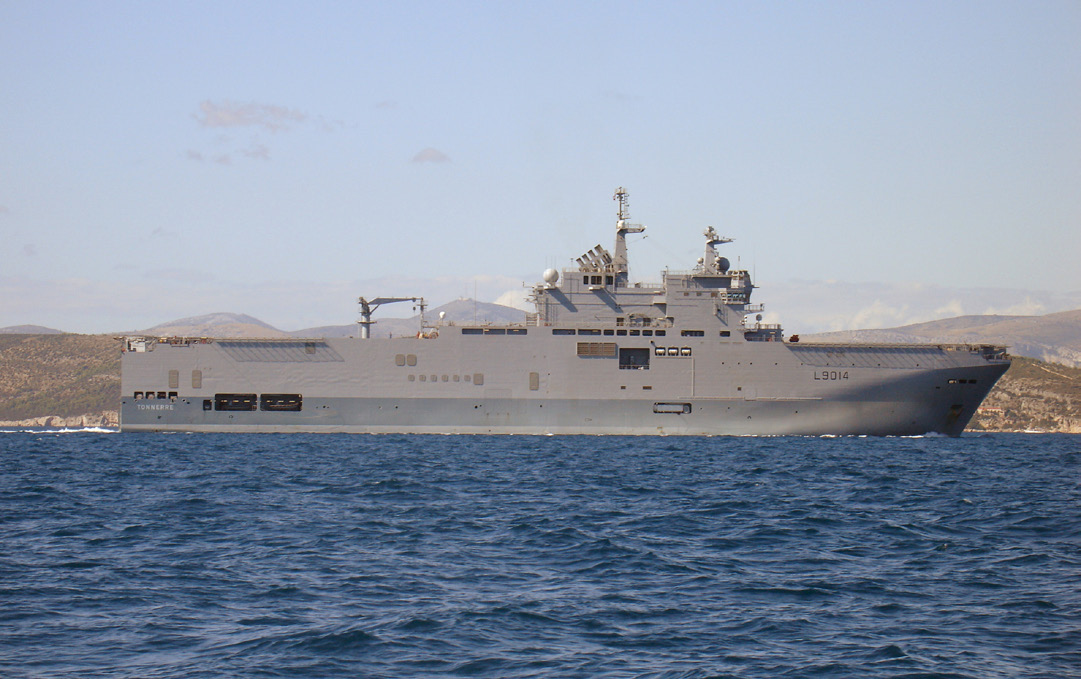
French amphibious assault ship Tonnerre (Wikipedia)
On April 5, 2021, the French Navy’s joint training “La Perouse” with Japan, the United States, Australia and India began in the Bay of Bengal, east of India. This joint training, sponsored by France, was held for the first time in May 2019, and India has joined for the first time this time. Captain Arnaud Tranchamp of the French amphibious assault ship Tonnerre called it “Demonstration of the ability of France to deploy in strategic regions,” and emphasized that they agreed to strengthen cooperation toward “a peaceful, secure and prosperous Indo-Pacific region.”
In addition, Japan and Germany held the first “Japan-Germany 2 Plus 2” on April 13 this year in commemoration of the “160th anniversary of Japan-Germany exchange”. The four ministers shared serious concerns about the situation in the East China Sea and South China Sea, where China is intensifying its marine expansion, and confirmed to cooperate in the realization of ‘security of the free and open Indo-Pacific.’ Germany plans to dispatch a frigate to the Far East in August.
Britain is also planning to dispatch a carrier strike group to the Far East in May, including the state-of-the-art aircraft carrier “Queen Elizabeth.” I would like to consider the background of the ‘security of the free and open Indo-Pacific’ for which global support is expanding and the challenges of Japan.
“Security of free and open Indo-Pacific” advocated by former Prime Minister Abe

6th Tokyo International Conference on African Development, Nairobi, Kenya (Prime Minister’s Office Homepage)
The 6th Tokyo International Conference on African Development (TICAD) was held in Kenya on August 27, 2016. In the keynote speech, Prime Minister Abe (then) announced the launch of the “Japan-Africa Public-Private Economic Forum” in order for the Japanese government to support the expansion of private companies into Africa. He also proposed the idea that “a permanent member of the UN Security Council should be sent out,” recognizing that Africa and Japan have entered into a mutually beneficial relationship.
He said that it is the “sea road” that connects Africa with Asia and Japan, and appealed that “Africa and Asia and Japan together shall take responsibility to make the ‘free and open Indo-Pacific’ that brings stability and prosperity to the world into a region where the rules govern and the market economy is valued.”
‘Free and Open Indo-Pacific’ that gained understanding
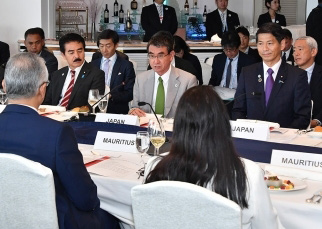
Special meeting entitled “Cooperation in the West Indian Ocean” at the 7th Tokyo International Conference on African Development in August 2019 (Foreign Minister Kono at the center, Ministry of Foreign Affairs website)
At the special meeting entitled “Cooperation in the West Indian Ocean” at the 7th Tokyo International Conference on African Development held in Yokohama in August 2019 following the previous one, Foreign Minister Kono (then) gave a speech as the chairman pointed out that “the West Indian Ocean region has a central sea lane connecting Asia, Africa and Europe, and is a promising region for the blue economy.” He explained, “The ‘Free and Open Indo-Pacific’ (FOIP) proposed by Prime Minister Abe at the previous TICAD consists of three pillars: (1) establishment of the rule of law, including freedom of navigation, (2) pursuit of economic prosperity, and (3) commitment to peace and stability,” and stated, “Japan which is an island nation will continue to support island nations with capacity building programs to cope with climate change and natural disasters and ‘quality infrastructure’ such as constructing revetment against tsunami, port facilities and port construction.”
Attendees from the West Indian Ocean coastal nations responded, saying, “Maintenance of a free and open maritime order in the West Indian Ocean is important, and securing the sustainable use of marine resources through promotion of the blue economy and crackdown on piracy and illegal, unreported and unregulated (IUU) fisheries, etc. are necessary”, and shared the recognition that it is in line with the ‘free and open Indo-Pacific concept’.
Prime Minister Abe himself actively meets with President Trump and Indian Prime Minister Modi
On November 30, 2018 (14:00 local time), Prime Minister Abe (then), while visiting Argentina to attend the G20 Summit, held the first Japan-US-India summit with US President Donald J. Trump and Indian Prime Minister Narendra Modi. At the 30-minute meeting, they frankly exchanged views on sharing basic values such as freedom, democracy, and the rule of law and strategic interests, confirmed the significance of “stability and prosperity in the Indo-Pacific region,” and agreed to strengthen cooperation.
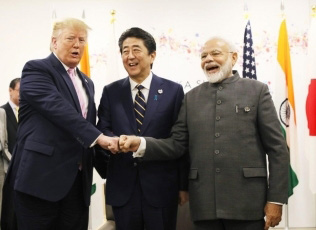
Japan-US-India Summit during G20 Osaka summit on June 28, 2019 (Photo courtesy of Cabinet Public Relations Office)
It can be said that the gaining of the understanding and support of President Trump (then) who announced his withdrawal from the TPP (Trans-Pacific Partnership) is a remarkable achievement for Japanese diplomacy. It is also a big decision for India, which shares a long border and continues confrontation with China in border dispute, has expressed its stance of prioritizing the basic values of freedom, democracy, and the rule of law. It can be said that the ‘Free and Open Indo-Pacific’ concept became an unwavering concept with the consent of the main nations.

Ministry of Foreign Affairs of Japan Home Page
Proactive engagement for peace – one of milestones of the 40th anniversary of the end of the war

In the 1980s, the so-called “Japan bashing” wind blew all over the United States and it was reported that Japanese cars were smashed with a hammer. The photo shows such image. (photo source: bivanis / 123RF). (February 5, 2017, posted by Vehicle News)
Here, I would like to reconsider the proactive peace diplomacy of former Prime Minister Abe. The idea behind it is ‘proactive engagement for peace’. In December 2013, the Second Abe Cabinet adopted ‘proactive engagement for peace’ as a “national security strategy.” The central axis of proactive engagement for peace is pacifism that does not change.
After World War II, Japan has extremely disliked and excluded actions that are considered to be ‘aggression’ by neighboring countries. Therefore, the debate on national defense and self-defense was kept to the minimum necessary, and postwar reconstruction has focused on science and technology, industry, and the economy in order to gain a reputation as a peaceful nation. Japan has thought that the world’s most advanced technological development and the high-quality products created from it will directly contribute to the world.
But that wasn’t enough. Because there was a big premise for that.
The US-Japan trade friction speaks for itself. The US-Japan trade friction started as defense costs were reduced to 1% of GNP and the industry developed, resulting in an increase of the US trade deficit between Japan and the United States. Beginning with US-Japan textile negotiations, restrictions on exports of home appliances to the US, and in the 1980s, the automobile export problem developed into a trade dispute between Japan and the US.
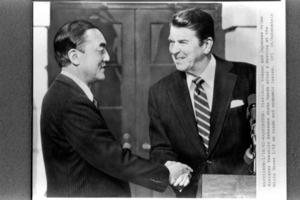
Prime Minister Yasuhiro Nakasone shaking hands with President Reagan after the summit meeting on his first visit to the United States = January 18, 1983, the White House
In January 1983, Prime Minister Yasuhiro Nakasone held his first summit meeting with President Reagan. It is said that the reason why he could establish the “Ron Yas relationship” was that he has shown his determination to surpass the GNP (gross national product) 1% limit for defense expenses. The frame was abolished in December 1986.
In other words, the biggest premise for Japan’s prosperity is that Japan belongs to the free and democratic camp of the United States and Europe and enjoys peace under the Japan-US Security Treaty, and economic development presupposed that. Furthermore, it cannot be said to be fair if Japan and the United States compete only on the ground of economic power. It means that we should think about the playing field of America. It can be said that Prime Minister Nakasone took this into consideration and responded with the determination to contribute to the world through Japan’s defense efforts and its role in world peace.
Proactive engagement for peace – second milestone of the 40th anniversary of the end of the war
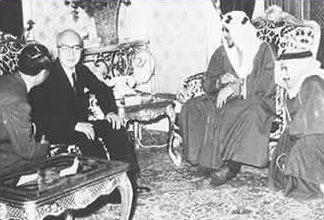
President Taro Yamashita meeting with the King of Saudi Arabia, December 10, 1957. After several months of difficult negotiations, the Japanese oil export company and the Saudi Arabian government signed an interest agreement for an oil development in an area off the neutral zone of Kuwait, Saudi Arabia.
Arabian Oil Company History I “Rooted in the Desert”
Here, I would like to point out another premise that forced Japan’s shift to the proactive engagement for peace.
Resources are indispensable for the reconstruction of industry and economy after the war. Among them, in terms of oil, which is indispensable as an energy resource, Japan depends almost 100% on imports. Moreover, as a bitter experience in World War II, the ‘self-developed oil field’ was an implicit national policy in order to avoid the risks posed by relying on imports. It was the Arabian oil field called the “Hinomaru oil field” that paved the way. It was the acquisition of development interests in offshore oil fields off Saudi Arabia and Kuwait.
The success of this self-developed oil field was a God-given event in which Japan seized the opportunity created by the sympathy of the oil-producing nations for Japan and the gap between the oil majors. It enabled the stable import of energy resources, which is the basis of industrial development.
However, oil crisis which occurred twice as the result of the impact from the Israeli-Arab Middle East war made Japan keenly aware of the necessity for the diversification of source nations for crude oil and alternative energy sources other than oil. Japan overcame the oil crisis through its energy mix policy.
Japan’s oil and natural gas self-development ratio
Trends from 1973 to 2019
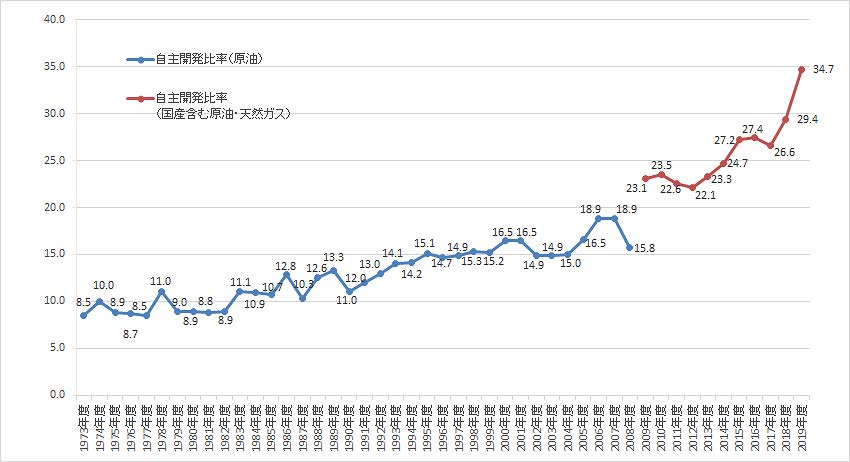
Note: From Fiscal Years 1973 to 2008, the self-development ratio was calculated for oil only, but after FY 2009, oil and natural gas have been added together and the self-development ratio has been publicized. (Published by the Ministry of Economy, Trade and Industry on July 22, 2020)
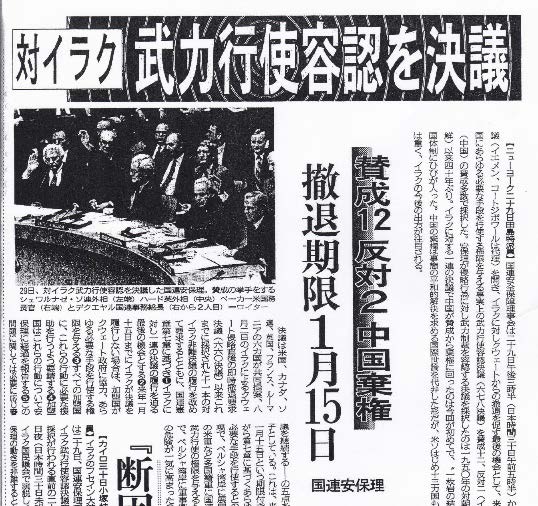
On November 29, the United Nations Security Council adopted the resolution 678 which virtually allowed use of force and all necessary measures to urge Iraq to withdraw from Kuwait with final deadline of January 15, 1991.(November 30, 1990 evening in the Chunichi Shimbun)
Then the Gulf Crisis and the Gulf War broke out in 1990-91.
By the time the Gulf War broke out, the Cold War had already ended. Despite the post-Cold War turmoil, the UN Security Council almost unanimously adopted the resolution demanding the withdrawal of Iraqi troops. What should Japan have done for Kuwait against Iraq, which refused to withdraw despite the resolution? Kuwait in the Gulf, a country that can be said to be a benefactor in Japan’s self-development of crude oil, was at the brink of destruction. On August 10, 1990, the emergency Arab Summit meeting was held in Cairo, and “adopted seven resolutions including the dispatch of the Arab Joint Forces, against Iraqi invasion of Kuwait”. The UN Security Council adopted a resolution which virtually allowed use of force at the end of November.
The Gulf Crisis must have been a life or death emergency for Japan as well. From the perspective of Japan which respects the United Nations, and Japan’s role in the Japan-US alliance, Japan should have expressed a clear stance toward the Gulf crisis. And the role of Japan should have been set forth concretely. However, Japan gave the world the impression that Japan’s attitude was ambiguous, lacks contribution of human resources and ‘aggressiveness’ for peace. The prestige of Japan, an economic powerhouse, has been damaged. It should not be forgotten that the criticism of “Japan’s free riding on security” erupted in the US Congress and some voiced criticism asking, “Is any one of the Japanese parliamentarians saying that he will help the United States when the United States is attacked?”.
Now that Japan regained lost prestige and reached a critical moment
The late Kaoru Yosano recalled that when the Gulf War ended before Japan could make a human contribution in the Gulf Crisis, he felt a sense of crisis, saying, “If nothing is done, Japan will become an orphan in the world.” Then, it was the dispatch of the Self-Defense Forces minesweeper to the Persian Gulf that he implemented immediately after he came up with the idea. It was April 1991. The Japanese flags and the Japanese Self-Defense Forces were visible to the people of the Gulf including Kuwait.
The United Nations Peace Keeping Cooperation Law was enacted in June 1992, and it has become possible to make efforts for world peace together with the United Nations through contribution of human resources. Japan built up the track record of international contributions through operations in Cambodia, Mozambique, Golan Heights, East Timor, and supply materials transportation activities for the relief of Rwandan refugees as Japan-initiated humanitarian international relief operation based on PKO. The evaluation of an international cooperation policy of Japan was established in 10 years.
After the terrorist attacks on the United States on September 11, 2001, Japan responded to President George W. Bush’s “War on Terror” with the Terrorism Special Measures Law. Japan then responded to the subsequent 2003 Iraq War with the Iraq Special Measures Law.

Canada Summit, October 2002

Dispatch of Self-Defense Forces to the Indian Ocean: Dispatch of Maritime Self-Defense Force supply ships and escort ships from 2001 to January 15, 2010. Venue security activities and refueling activities in the Indian Ocean based on the Terrorism Special Measures Law with validity period limited. (The photo is from the Mainichi Shimbun, July 19, 2009 issue)
‘Free and open Indo-Pacific’ appealed over 30 years of history
At the time of the Great East Japan Earthquake, Japan received “heartfelt donations” from all over the world. Not only that, the United States has conducted Operation Tomodachi. Furthermore, a special medical team of more than 50 medical personnel was sent from Israel which is far away.
The second Abe Cabinet, which was established one and a half years after the Great Earthquake, set out proactive peace diplomacy toward the world under the turmoil and negative circumstances of Japan. The ‘proactive’ peace diplomacy was set out on the foundation of Japanese efforts for international contribution including Self-Defense Forces’ efforts for peace towards the world over 20 years after the Gulf War.
Japan is peaceful under the umbrella of the Japan-US Security Treaty, and to what extent does Japan share the role of the umbrella itself? How is Japan going to share it? In other words, the “proactive engagement” aspect of Japan’s pacifism was being questioned.
Abe diplomacy responded by advocating the diplomacy of ‘proactive engagement’ for peace and advocating the ‘free and open Indo-Pacific’ concept. The world is understanding and accepting Japan’s vision. The diplomacy and security advocated by Japan was able to receive worldwide support because such historical efforts and consistent pacifism were recognized. (April 24, 2021)
